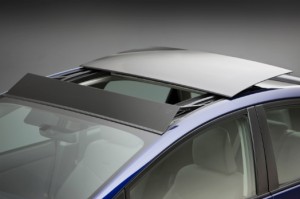By John Addison. Toyota achieves a record 50 miles per gallon with the new 2010 Prius, which just made its formal debut at the North American International Auto Show. This article also covers Toyota’s latest plug-in hybrid and EV announcements.

Since the Prius was first went on sale in Japan in 1997, continuous improvements have been made. My 2002 Prius has a combined EPA rating of 41, and that has been its actual mileage. Newer models are rated at 46 mpg. The new 2010 should be rated at 50 miles per gallon, or better. Toyota
In addition to normal driving, Prius now comes with three selectable modes – EV, Eco and Power – to accommodate a wide range of driving conditions.
Hybrid components like the inverter, motor, and generator are now smaller and lighter. The new midsized 2010 Prius improves fuel efficiency with a 0.25 coefficient of drag making it the world’s most aerodynamic production vehicle. Hybrid components like the inverter, motor, and generator are now smaller and lighter. The new beltless 1.8-liter, 4-cylinder gas engine with 98 horsepower, runs at lower RPMs at highway speeds for better fuel efficiency and improved uphill performance. An exhaust heat recovery system, exhaust gas recirculation, and an electric water pump contribute to a more efficient hybrid system with a net horsepower rating of 134.
An exciting new option is the solar moonroof using Kyocera PV that automatically powers a ventilation system on hot days. This system allows fresh air to circulate into the vehicle, cooling down the cabin so that the A/C doesn’t have to work as hard, conserving battery power. The solar roof will be paired with a remote air-conditioning system that is the first in the world to run on battery power alone. LED head lamps are another exciting energy saving option.
Better mileage is also the result of using lighter materials. Weight was saved through use of aluminum in the hood, rear hatch, and some other components. Toyota uses plant-derived, carbon-neutral plastics in the 2010 Prius. This “ecological plastic” will be used in the seat cushion foam, cowl side trim, inner and outer scuff plates, and deck trim cover.
The new Prius will get an enthusiastic greeting from the owners who now drive over 1 million Priuses and have put over 37 billion miles on their hybrids.
Toyota is also accelerating its roll-out of plug-in hybrids. Beginning in late 2009, Toyota will start global delivery of 500 Prius plug-in hybrids powered by lithium-ion batteries. Of these initial vehicles, 150 will be placed with U.S. lease-fleet customers.
The first-generation lithium-ion batteries powering these plug-in hybrids will be built on an assembly line at Toyota’s Panasonic EV Energy Company battery plant, a joint-venture production facility in which Toyota owns 60 percent equity. During its development, the new Prius was designed and engineered to package either the lithium-ion battery pack with plug-in capability, or the nickel-metal hydride battery for the conventional gas-electric system.
The Prius will face increased competition. The new Honda Insight 4-door sedan, 5-seater, with an Ecological Drive Assist System is expected to be priced for thousands less than the Prius. Honda will start selling the Insight in North America in spring 2009. The Insight will have a combined EPA rating of 41 miles per gallon, over 20 percent less than the 2010 Prius.
The new Ford Fusion Hybrid midsize 4-door sedan will be on sale in the US this next spring, with an EPA certified 41 mpg rating in the city and 36 mpg on the highway. The Fusion Hybrid and Mercury Milan Hybrid may travel up to 47 miles per hour in pure electric mode. The Advanced Intake Variable Cam Timing allows the Fusion and Milan hybrids to more seamlessly transition between gas and electric modes.
Toyota plans to make a hybrid drive system optional on all vehicles by 2020. At the North American International Auto Show, Toyota confirmed its plan to launch a battery-electric vehicle (BEV) by 2012. The FT-EV concept shares its platform with the revolutionary-new iQ urban commuter vehicle. Toyota continues to give customers an increasingly exciting selection of fuel-efficient hybrids, plug-in hybrids, and electric vehicles.
John Addison publishes the Clean Fleet Report. His new book – Save Gas, Save the Planet – goes on sale March 25.
